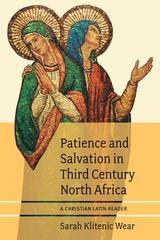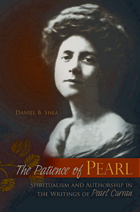3 books about Patience

Patience and Salvation in Third Century North Africa
A Christian Latin Reader
Sarah Wear
Catholic University of America Press, 2022
Patience and Salvation in Third Century North Africa: A Christian Latin Reader features the entirety of Tertullian’s To Martyrs and The Passion of Perpetua and Felicity, with selections from Cyprian’s On the Good of Patience and a short appendix on Augustine’s Commentary on Psalm 121.6. The Latin text has facing vocabulary and theological, historical, philosophical, and grammatical notes.
In the first three centuries, Roman Carthage produced some of the earliest literature composed originally in Latin by Christians. Tertullian’s Ad Martyras (197); Passio Perpetuae et Felicitatis (203), and Cyprian’s De Bono Patientiae (256) all embody the force of this new genre of Latin literature. With this literature, we see a variant of Latin often denoted “Christian Latin.” Christian Latin featured linguistic elements marked by characteristics of biblical Latin, later Latin, as well as vulgarisms.
In addition to converging philologically, Tertullian, the author of the Passio, and Cyprian align themselves in topos: they all ask the question of how one can endure torment and anxiety in this world. Patience (patientia), derived from the verb for “to suffer” (patior), is a virtue that allows one to endure troubles, anxieties, and physical pains with the hope of eternal happiness and salvation in heaven. In this Reader, the student will find three different literary perspectives on this theme. The book also draws parallels to the works of Seneca and Cicero on patience and suffering.
[more]

The Patience of Ice
Renate Wood
Northwestern University Press, 2000
Filled with awe at the improbable, incomprehensible trajectory of human experience, Renate Wood ponders history, memory, and family. Beginning with the sequence titled "German Chronicle," Wood evokes her childhood in Germany during the WWII, recording the war's impact on the world in general and on her family in particular. Her poems move between the past and the present, from family life to mythology, and are distinguished by intellectual and emotional courage, metaphoric surprise, and linguistic clarity.
[more]

The Patience of Pearl
Spiritualism and Authorship in the Writings of Pearl Curran
Daniel B. Shea
University of Missouri Press, 2012
When St. Louis homemaker Pearl Curran began writing fiction and poetry at a Ouija board in 1913, she attributed the work to the “discarnate entity” Patience Worth, a seventeenth-century Puritan. Though now virtually forgotten, her writing garnered both critical praise and public popularity at the time. The Patience of Pearl uncovers more of Curran’s (and thus Patience Worth’s) biography than has been known before; Daniel B. Shea provides close readings of the Patience-dictated writings and explores the historical and local context, applying current cognitive and neuro-psychology research.
Though Pearl Curran had only a ninth-grade education, Patience Worth was able to dictate a biblical novel and a Victorian novel. Echoes of Dickens and the Potters, a circle of St. Louis women writers, make clear that Patience Worth reflects literary debts that go as far back as Curran being read to as a child. Shea argues that the workings of implicit memory suggest the medium’s creative achievements were her own body’s property. Curran also had musical training, and recent developments in the field of psychology regarding the overlap between musical and linguistic rhythms of regularity, anticipation, and surprise supply a firm foundation for attributing skills both automatic and creative to Curran. Her reflections on her doubleness in her self-study anticipate the many-personed Ouija board writing of poet James Merrill.
Shea approaches Curran/Worth as a summary figure for the Victorian-era woman writer’s buried voice at the point of its transition into modernism. He investigates many lingering questions about Curran’s fluent productivity at the Ouija board, including the “smart” versus “dumb” unconscious. Shea links unconscious memory, dissociation, and automatic writing and reconsiders problematic assumptions about individual identity and claims of personal agency. The Curran/Worth Puritan/writer figure also allows scrutiny of gendered assumptions about the dangers of female speech and the idealization of women’s passive reception of divine, or husbandly, revelation.
Novelistic in its own way, Curran’s life included three husbands and a child adopted on command from Patience Worth. Pearl Curran enjoyed a brief period of celebrity in Los Angeles before her death in 1937. The Patience of Pearl once again brings her the attention she deserves—for her life, her writing, and her place in women’s literary history.
[more]
READERS
Browse our collection.
PUBLISHERS
See BiblioVault's publisher services.
STUDENT SERVICES
Files for college accessibility offices.
UChicago Accessibility Resources
home | accessibility | search | about | contact us
BiblioVault ® 2001 - 2024
The University of Chicago Press









